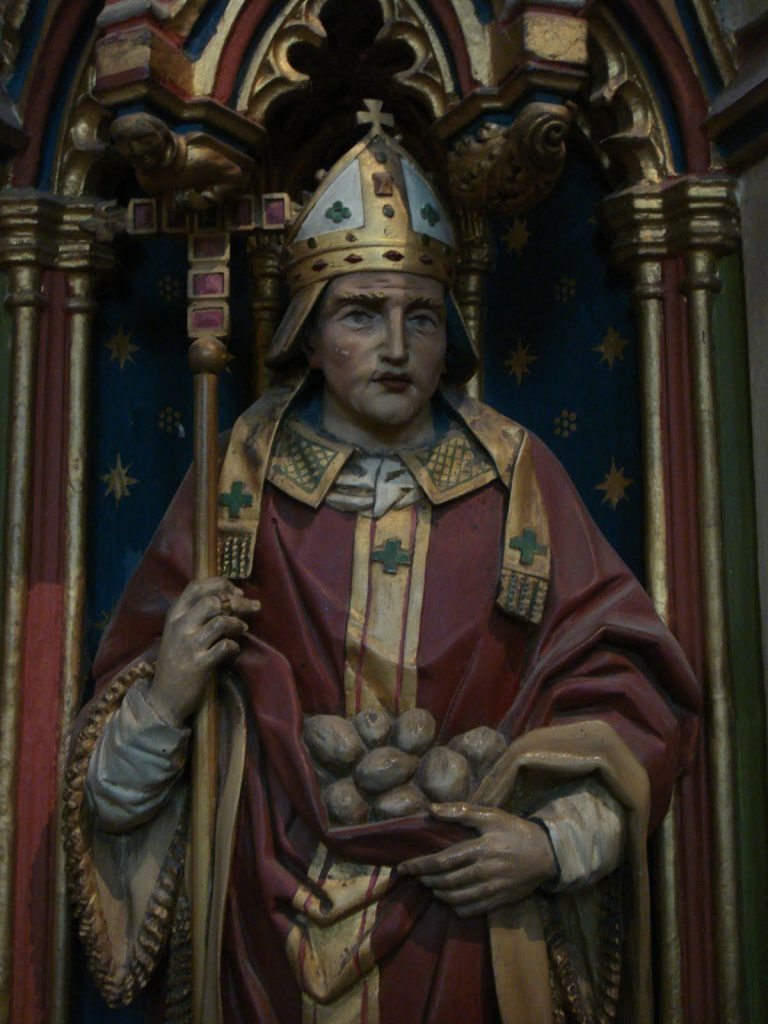St Alphege 19th April
This month’s saint is an Anglo Saxon Cleric who during his life played a significant role in integrating the Danish invaders of Britain into Anglo- Saxon society as part of the British race and who despite this was martyred by the Danes being the first Archbishop of Canterbury to die as a martyr. The writer selected him from the list of saints in the calendar for April because he was acquainted with St Alphege’s Church at Greenwich, although not realising that it was the site of the saint’s martyrdom, and on looking in Wikopedia the writer discovered that the saint was born in a village near Bath where the writer was brought up without realising it was the birth place of a saint. Clearly St. Alphege was a bit short on publicity which perhaps justifies an article about him.

Alphege (or to give him his anglo-saxon name AElfheah) was born about 953AD and became a monk at a monastery at Deerhurst. It has also been suggested that he served as a monk at Glastonbury but there is no hard proof of this. What is certain is that he then moved to Bath Abbey. He fancied the contemplative life and became an Anchorite or hermit living a solitary life in a cave in the Bath area. Here he built up a reputation for good works and a source of sound advice and became something of a cult figure. He then moved back into the Abbey becoming the Abbot about 980AD. His reputation as a source of sagacity was now well established and even the king, Ethelred the Unready sought his opinion.
In 984AD probably due to the influence of St Dunstan, the Archbishop of Canterbury, he was translated to the see of Winchester. Now, in the then capital of England. as well as administering the diocese he became King Ethelred’s principal source of advice. At this time the Danes had taken control of a large part of England and were threatening the kingdom. Alphege recognised that they were here to stay and the future lay in making peace with them and absorbing them into the English nation. With this in mind he negotiated for Ethelred a treaty of peace with one of the main norse raiders, Olaf Tryggvason, who having been paid danegeld agreed that he would never raid or fight the English and would support Ethelred. Olaf and and his followers also adopted Christianity and were received by Alphege into the Church. Alphege did not allow his work for Ethelred to interfere with his running of the Winchester diocese. He enlarged and improved a number of churches, promoted the veneration of St. Swithin, the founder of Winchester Cathedral, and also of Alheah his immediate predecessor as Bishop and also ordered the construction of a large organ at the Cathedral that could be heard over a mile away and required twenty four men to pump it.
In 1006AD he succeeded Aelfric as Archbishop of Canterbury and he took with him from Winchester the head of St Swithin as a relic. In 1007AD he travelled to Rome to be confirmed as Archbishop by Pope John XVIII. On the return journey he was set upon by robbers but managed to escape unharmed. The five years that he had administering the Archdiocese were largely a period of consolidation with changes to the liturgy, improvements in education and training of priests and a continuing dialogue with the Danish invaders.
Although there was by now a sizeable number of Danes settled in England beginning to regard themselves as English and acknowledging Ethelred as king, there were still incursions and raids from other Danes and Norsemen plundering English towns for money and valuables. One such raid occurred in September 1011 when the Danes laid siege to Canterbury, and after 21 days took the town, plundered, sacked and burned the Cathedral and took a number of prisoners to hold for ransom including Archbishop Alphege.
The Archbishop was held prisoner by the Danes until 19th April 2012 but he refused to allow himself to be ransomed and on that day the Danes got fed up with holding him and getting no money to release him. They therefore called a council to decide what to do with him. It is reported in the Anglo-Saxon Chronicles that most of the Danish raiders were drunk on looted wine and the council descended into a drunken brawl. The Danes, enraged at receiving no money as a ransom, had Alphege brought before them and abandoning any pretence of a trial pelted him with bones and other debris from the rubbish pit. Alphege was hit and fell to the ground. It is said that one Danish leader, Thorkell the Tall, was so appalled at the treatment of the saint that offered to let the killers have all his wealth, other than his ship to free Alphege but the other Danes refused and continued to cruelly misuse the saint and one of the Danes eventually struck Alphege on the head with the back of his axe killing him instantly. Some sources allege that this final blow was struck by a Christian Dane named Thrum as an act of mercy to save the saint from further ill treatment and a painful death at the hands of the mob. So died a pious and wise churchman, a diplomat, adviser and counsellor of kings who paid a significant role in the history of England in the middle ages. Thorkell the Tall is said to have been so impressed by the saint’s demeanour that he converted to Christianity and bonded himself and his men to serve Ethelred.
The Saint’s body was buried at St Paul’s Church in London and was moved from there in 1023 by King Canute who had ascended the English throne. With great ceremony Canute, presumably as some expiation for Alphege’s death at the hand of the Danes, had the body removed to Canterbury Cathedral where it was enshrined. When the Cathedral was destroyed by fire in 1174 the body together with that of St Dunstan was enshrined at the high altar rebuilt cathedral.. Alphege was canonised as a martyr by Pope Gregory VII in 1078. A church dedicated to St. Alphege was built at the site of his death at Greenwich. St Alphege is also the Patron Saint of hostages and kidnap victims.

